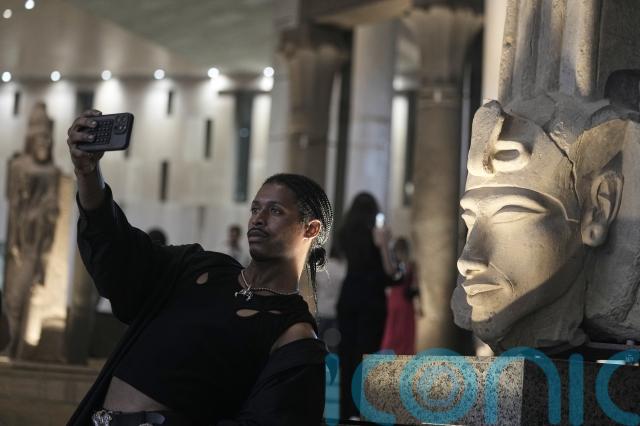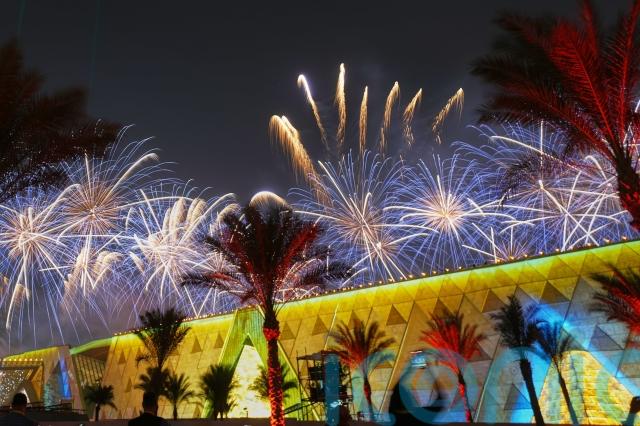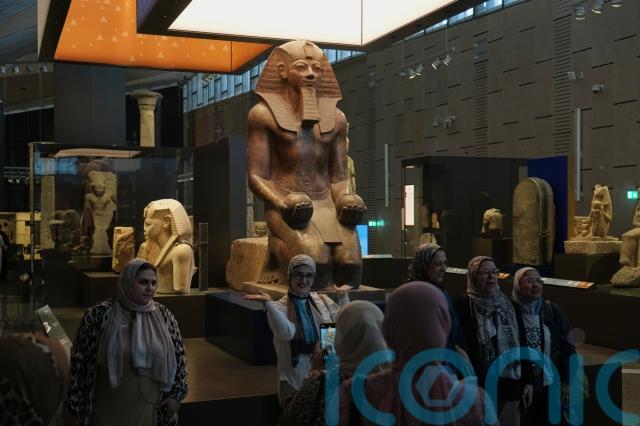
In an extravaganza of pharaonic imagery with a drone light show depicting ancient gods and pyramids in the sky, Egypt inaugurated its long-delayed Grand Egyptian Museum, a megaproject aiming to give the country’s millennia-old heritage a rich, modern display.
Two decades in the making, the museum located near the Giza Pyramids and Sphinx is the centrepiece of the government’s bid to boost Egypt’s tourism industry and bring cash into the troubled economy.
At the elaborate grand opening ceremony on Saturday, attended by a number of European and Arab royals and other presidents and prime ministers, Egyptian President Abdel Fattah el-Sissi sought to give the event an international scale.
He called on attendees to “make this museum a platform for dialogue, a destination for knowledge, a forum for humanity, and a beacon for all who love life and believe in the value of humankind”.

The museum, known as GEM, is one of several megaprojects championed by Mr El-Sissi since he took office in 2014, embarking on massive investments in infrastructure with the aim of reviving an economy weakened by decades of stagnation and battered by the unrest that followed the 2011 Arab Spring uprising.
Egypt’s pharaonic history has long made it a tourist magnet. But it has also struggled to organise and display the huge amount of artifacts: everything from tiny pieces of jewellery and colourful tomb murals to towering statues of pharaohs and animal-headed gods, with more discoveries are constantly being made across the country.
Touted as the world’s biggest museum dedicated to a single ancient civilization, the new building, in a contemporary style, aims to correct that.
Its large, open halls give space and rich explanations for some 50,000 artifacts on display, along with virtual reality exhibits.

It displays the entire collection of treasures from the tomb of the famed King Tutankhamun for the first time since its discovery in 1922.
The museum replaces the Egyptian Museum, housed in a building more than a century old in downtown Cairo that – while elegant in its Neo-Classical style – had become antiquated and was often compared to a warehouse, overpacked with artifacts with little explanation.
Construction on the £760 million project began in 2005 under then-president Hosni Mubarak.
But work was interrupted by turmoil surrounding the 2011 uprising that brought him down.

Further delays ensued, and a planned grand opening over the summer had to be put off after the 12-day-long war between Israel and Iran erupted in June.
GEM is expected to attract 5.0 million visitors annually, said Egypt’s tourism and antiquities minister, Sherif Fathy.
That would put it in the realm of the most popular museums in the world.
In 2024, by comparison, Paris’s Louvre brought in 8.7 million, the British Museum 6.5 million and the Metropolitan Museum of Art in New York 5.7 million.

The museum boasts a towering, triangular glass facade imitating the nearby pyramids, with 24,000 square metres of permanent exhibition space.
It opens to a granite colossus of Ramses the Great, one of ancient Egypt’s most powerful pharaohs who reigned for about 60 years, from 1279-1213 BC, and is credited with expanding ancient Egypt’s reach as far as modern Syria to the east and modern Sudan to the south.
The statue greets visitors once they step inside the museum’s angular atrium.
The museum’s 12 main galleries, which opened last year, exhibit antiquities spanning from prehistoric times to the Roman era, organised by era and by themes.

Two halls that will be opened for the first time after Saturday are dedicated to the 5,000 artifacts from the collection of King Tutankhamun — a boy pharaoh who ruled from 1361-1352 BC.
The tomb was discovered by British archaeologist Howard Carter in 1922 in the southern city of Luxor. But the old Egyptian Museum did not have enough room to display the whole collection.
The collection includes the boy pharaoh’s three funeral beds and six chariots, his golden throne, his gold-covered sarcophagus and his burial mask, made of gold, quartzite, lapis lazuli and coloured glass.
Zahi Hawass, Egypt’s most renowned archaeologist and former minister of antiquities, said the Tutankhamun collection is the museum’s masterpiece.
“Why this museum is so important, and everyone is waiting for the opening?” he told The Associated Press. “Because of Tutankhamun.”
Subscribe or register today to discover more from DonegalLive.ie
Buy the e-paper of the Donegal Democrat, Donegal People's Press, Donegal Post and Inish Times here for instant access to Donegal's premier news titles.
Keep up with the latest news from Donegal with our daily newsletter featuring the most important stories of the day delivered to your inbox every evening at 5pm.